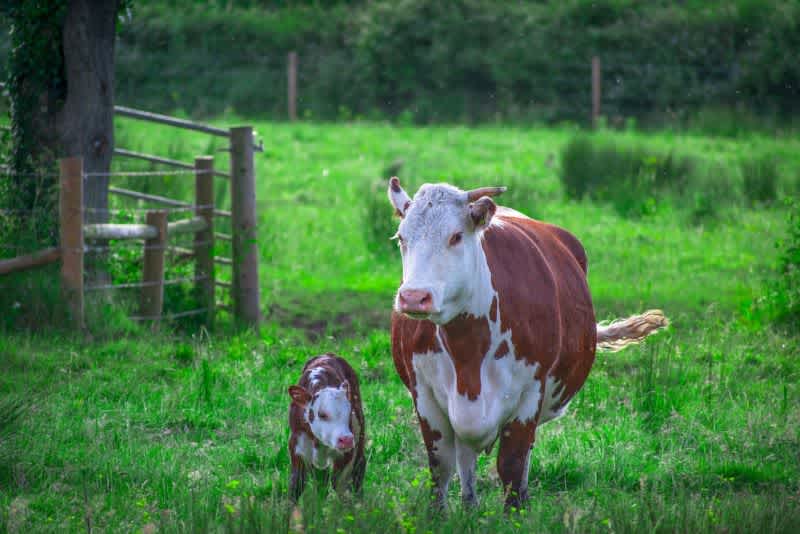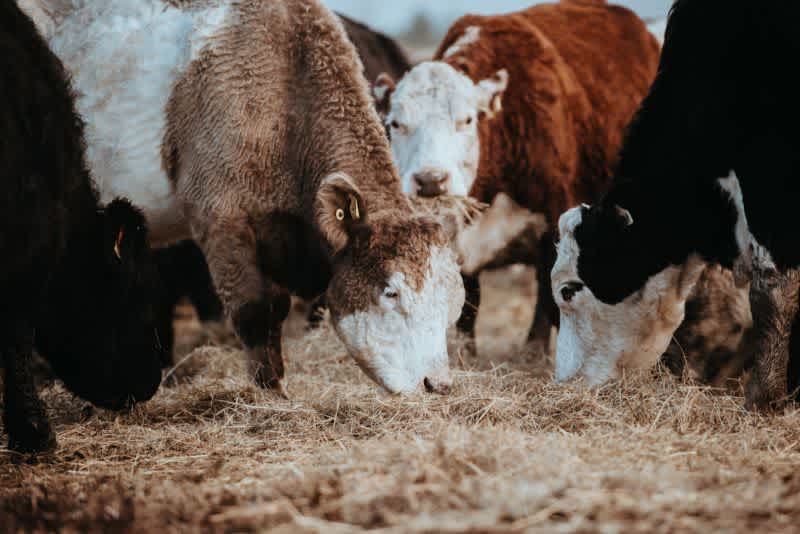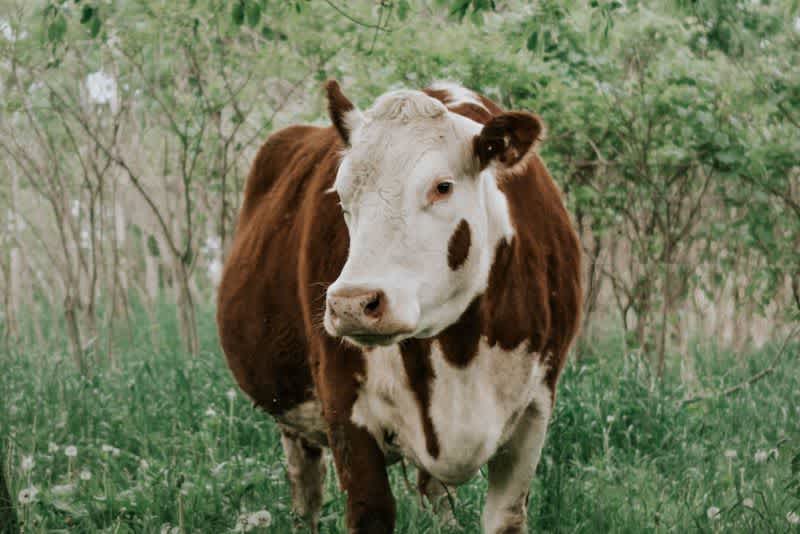How Long Are Cows Pregnant? 6 Factors Influencing Gestation
Published: October 9, 2023

If you’re a farmer looking to successfully manage your herd’s reproduction, understanding how long cows are pregnant is an important question to get right.
Understanding the length of gestation and the various factors that can influence it can help you make informed decisions about breeding, nutrition, and herd management, ultimately leading to a healthier and more productive herd.
In this article, we'll dive into everything you need to know about a cow’s pregnancy, from the gestation length to the various factors that can impact it. So whether you're a seasoned dairy farmer or just getting started in the industry, this information is essential for ensuring the health and productivity of your herd.
How Long Are Cows Pregnant?

Cows are usually pregnant for around 9 months, or approximately 280 to 290 days. However, the exact length of gestation can vary slightly depending on factors such as breed, nutrition, and environmental conditions which we will get into.
Farmers and ranchers must monitor their cows closely during pregnancy and provide proper care and nutrition to ensure healthy calves and successful births.
How Long is a Cow's Gestation Period?
Gestation refers to the period during which a fetus develops within the uterus of a female mammal, including humans and animals like cows. As mentioned, cow gestation periods are typically around 9 months or 280-290 days.
6 Main Factors That Influence Cow Gestation
Here are some main factors influencing the length of the cow gestation period.
1. Breed
Different cow breeds may have slightly different gestation lengths due to genetic differences that affect fetal growth and development, such as variations in fetal size.
Aberdeen Angus and Holstein Friesian are among the cattle breeds with the shortest gestation periods, while Brown Swiss cows have the longest gestation. However, individual variations within a breed can also impact gestation length.
2. Nutrition

Nutrition can significantly impact the gestation length in cows because fetal growth and development depend on the nutrients the dam provides.
Inadequate nutrition during the cow’s pregnancy can result in a smaller calf, while high-energy diets can lead to larger calves. Providing a cow’s diet with balanced, high-quality, protein-rich feed during pregnancy is more likely to ensure healthy fetal development and successful births.
3. Environmental Conditions
Environmental conditions can affect a cow's gestation length in several ways, such as exposure to heat stress, extreme cold, or other physical stressors that can interfere with the cow's health and nutrition.
Heat stress, in particular, may lead to premature calving and shorter gestation periods. Maintaining a comfortable and consistent environment for pregnant cows can help reduce stress and promote healthy fetal development.
4. Gender
Gender does not typically significantly impact the gestation length in cows, as the gestation period is largely determined by genetic and environmental factors rather than the sex of the calf.
However, bull calves tend to be slightly larger and may have longer gestation periods (this could be up to 2 days longer). In comparison, female fetuses may be slightly smaller and have shorter gestation periods.
These differences, however, are generally minor and not a major factor in determining gestation length.
5. Number of Calves

The number of calves a cow carries can influence the gestation length. Carrying multiple fetuses can be physically demanding for the cow and may require a longer gestation period to ensure proper fetal development.
Twin calves tend to be born slightly earlier than single calves (usually a couple of days to a week) and even earlier when calving triplets (close to two weeks).
6. Genetics
A cow's genetics can influence the length of gestation in several ways, such as determining the size of the fetus.
Stages of Cow Pregnancy
To truly understand how long cows are pregnant, it’s important to learn what triggers the calving process in cows.
There are three stages of cow pregnancy from fertilization to birth:
Early Embryonic Development
Fetal Development
Parturition (Birth)
Stage 1: Early Embryonic Development
During pregnancy's early embryonic development stage, the fertilized egg undergoes cell division and travels through the oviduct to the uterus, which implants into the uterine lining.
The development of the placenta is triggered, providing the necessary oxygen and nutrients to the developing embryo.
Stage 2: Fetal Development
During the fetal development stage of pregnancy, the embryo grows and develops into a calf.
The fetus undergoes significant growth and development, including the formation of vital organs and systems such as the respiratory, digestive, and nervous systems.
The fetus also gains weight rapidly during this stage, with most fetal growth occurring in the final trimester of pregnancy.
Hormonal changes continue to regulate the pregnancy, including progesterone production to maintain the pregnancy and the release of estrogen to prepare for parturition (birth).
This stage can last from implantation to the onset of labor, ranging from 280 to 290 days, depending on breed, nutrition, and environmental factors.
Stage 3: Parturition (Birth)
This stage involves the calf's delivery and the placenta's expulsion, usually within a few hours after birth.
When the cow is giving birth, it undergoes another three stages from labor to delivery:
Stage 1 (Cervix Dilation): This is the preparatory stage, which involves the dilation and thinning of the cervix in preparation for delivery. It can last up to 24 hours, sometimes only 6 hours for mature cows.
Stage 2 (Calf Delivery): This is the active delivery stage, which involves the expulsion of the calf from the uterus through the birth canal. It usually lasts 30 minutes for mature, older cows and an average of 1 hour for first-calf cows (also known as heifers).
Stage 3 (Placenta Delivery): This is the expulsion of the placenta, which occurs within 12 hours after the calf is born. The placenta should be expelled in healthy cows within a few hours after birth.
Each stage of the delivery process is important for ensuring a safe and successful birth, and farmers and veterinarians need to monitor cows closely during labor and delivery to intervene if necessary.
How Can You Tell a Cow Is Pregnant?

Here are some ways to tell if a cow is pregnant:
Rectal palpation: A veterinarian or experienced animal handler can palpate the cow's uterus through the rectum to feel for the presence of a fetus.
Ultrasound: An ultrasound machine can visualize the fetus and confirm pregnancy.
Blood or milk tests: Hormone tests can be performed on a cow's blood or milk to detect pregnancy-specific hormones the developing fetus produces.
Behavior changes: Some cows may exhibit changes in behavior or appetite when pregnant, such as becoming restless, aggressive, or gaining weight.
Physical changes: As pregnancy progresses, a cow's udder may enlarge, and her vulva may become more relaxed or loose. However, these changes may also occur due to other factors, such as recent calving, so they are not always reliable indicators of pregnancy.
How Can You Tell a Cow Is About to Give Birth?
There are several signs that a cow is about to give birth, including:
Restlessness: The cow may appear restless and pace around or lie down and stand up frequently.
Swollen vulva: The vulva may appear enlarged and swollen and discharge mucus or fluid.
Bagging up: The udder may become swollen and fill with milk, a process known as "bagging up."
Loss of appetite: The cow may lose its appetite as birth approaches.
Separation: The cow may separate herself from the herd and seek a quiet, secluded place to give birth.
Contractions: As labor begins, the cow may experience contractions as abdominal muscles tense and relax.
Conclusion
We hope you've better understood how long cows are pregnant and the various factors that can impact their gestation period. By carefully managing your herd's reproductive health, you can ensure that your cows remain healthy, productive, and profitable for years.
Whether you're looking to expand your herd, improve your milk production, or simply maintain a healthy and happy group of cows, understanding how long cows are pregnant is key to helping your farm thrive!
Frequently Asked Questions
How many months is a cow pregnant?
A cow is typically pregnant for 9 months, or approximately 280 days. This can vary slightly depending on breed, nutrition, environment, and other factors.
How many times does a cow give birth in a year?
A cow usually gives birth once per year, as their gestation period is approximately 9 months, and they require time to recover and prepare for their next pregnancy. However, some farmers may breed their cows more frequently to increase their herd size or milk production.
How long is a Longhorn pregnant?
Longhorn cows have a gestation period similar to other breeds of cows, which is approximately 9 months or 280 days.
How long can cows have babies?
Cows can give birth to calves throughout their reproductive lifespan, typically lasting 2 to 8 years, depending on breed and management practices. After this age, their reproductive ability may decline, and they may have fewer successful pregnancies.
What time of year do cows give birth?
The best calving season is in the spring or early summer, between March and June in the Northern Hemisphere, and between August and December in the Southern Hemisphere. Calves born during this time allow for optimal calf growth and development during the warmer months when food sources are more abundant, temperatures are mild, and days are longer.
How many babies does a cow have in one pregnancy?
Cows normally have one calf per pregnancy. However, there are rare cases of cows giving birth to twins, but this is uncommon and can sometimes result in health complications for both the mother and calves.
How many times can a cow give birth?
Depending on breed and management practices, a cow can give birth multiple times throughout its reproductive lifespan, lasting 2 to 8 years. The exact number of successful cow pregnancies can vary depending on the individual cow's health and fertility, but this means a cow can theoretically give birth around 8 times in their lifetime.
How many years can a cow have babies?
A cow's reproductive lifespan typically lasts from 2 to 8 years, depending on breed and management practices, during which time she can have multiple successful pregnancies. After this age, their reproductive ability may decline, and they may have fewer successful pregnancies.
How often is a cow pregnant?
Cows are generally pregnant once per year, with a gestation period of approximately 9 months or 280 days. Some farmers may breed their cows more frequently to increase their herd size or milk production.
Keep track of all your cattle with the #1 Cattle Management Software
Try out Ranchr today for free